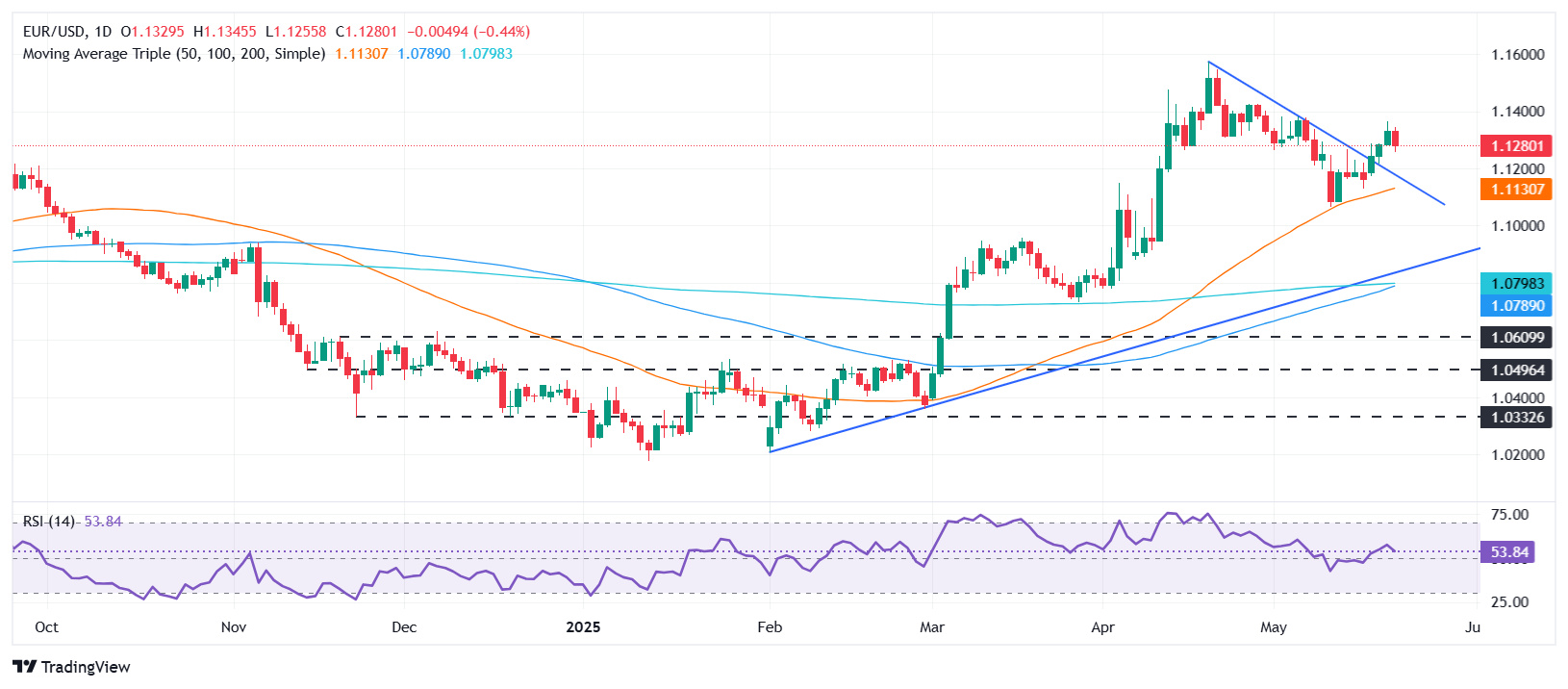Created
: 2025.05.23














![]() 2025.05.23 03:53
2025.05.23 03:53
EUR/USD tumbled below 1.1300 on Thursday as economic data from the United States (US) fared better than expected compared to Eurozone Flash Purchasing Managers Index (PMI) figures for May. At the time of writing, EUR/USD trades at 1.1271, down by 0.55%.
The US equity markets turned slightly positive as President Donald Trump's "One Big Beautiful Bill" passed the House of Representatives. Next, the Senate will discuss and tweak Trump's tax and spending cut proposal before passing the bill.
The news boosted the Greenback, which extended its appreciation against the shared currency as US S&P Global Purchasing Managers Indices (PMIs) for May exceeded estimates, reaffirming the economy's solidity.
Other data showed that the number of US citizens applying for unemployment benefits dipped compared to estimates and the previous week's data, a relief for the Federal Reserve (Fed), which has the dual mandate of price stability and maximum employment.
Fed Governor Christopher Waller crossed the news wires and said that if tariffs are close to 10%, the economy would be in good shape for the second half of 2025. He added that in that scenario, the Fed could resume its easing cycle later in the year.
Across the pond, the HCOB preliminary PMIs in France, Germany and the Eurozone unexpectedly contracted in May. At the same time, the German IFO Business Climate survey improved slightly in May.
In the meantime, some European Central Bank (ECB) policymakers crossed the wires. Yannis Stournaras questioned the safety of the US Dollar and created an opportunity for the Euro.
ECB Vice-President Luis De Guindos said inflation could return to the ECB's 2% target soon while economic growth turns weaker. ECB's Boris Vujčić noted that inflation could get close to the target by the end of 2025.
This week, the EU's economic docket will feature GDP data in Germany and ECB speakers. The US schedule will feature housing data and Fed speakers.
From a technical perspective, EUR/USD is set for a pause in its ongoing rally. A 'bearish engulfing ' chart pattern looms, which could pave the way for further downside as the pair hit a two-day low of 1.1255.
Although momentum remains bullish, as depicted by the Relative Strength Index (RSI), the RSI is edging towards the 50-neutral line, indicating buyers are losing momentum.
If EUR/USD prints a daily close below 1.1300, this could pave the way to test 1.1255. Once surpassed, the next floor level would be the 1.1200 mark, ahead of the 50-day Simple Moving Average (SMA) at 1.1138.
On the flip side, if EUR/USD climbs past 1.13, further gains are seen, with the first resistance being the latest cycle high at 1.1362, the May 21 daily peak.

The Euro is the currency for the 19 European Union countries that belong to the Eurozone. It is the second most heavily traded currency in the world behind the US Dollar. In 2022, it accounted for 31% of all foreign exchange transactions, with an average daily turnover of over $2.2 trillion a day. EUR/USD is the most heavily traded currency pair in the world, accounting for an estimated 30% off all transactions, followed by EUR/JPY (4%), EUR/GBP (3%) and EUR/AUD (2%).
The European Central Bank (ECB) in Frankfurt, Germany, is the reserve bank for the Eurozone. The ECB sets interest rates and manages monetary policy. The ECB's primary mandate is to maintain price stability, which means either controlling inflation or stimulating growth. Its primary tool is the raising or lowering of interest rates. Relatively high interest rates - or the expectation of higher rates - will usually benefit the Euro and vice versa. The ECB Governing Council makes monetary policy decisions at meetings held eight times a year. Decisions are made by heads of the Eurozone national banks and six permanent members, including the President of the ECB, Christine Lagarde.
Eurozone inflation data, measured by the Harmonized Index of Consumer Prices (HICP), is an important econometric for the Euro. If inflation rises more than expected, especially if above the ECB's 2% target, it obliges the ECB to raise interest rates to bring it back under control. Relatively high interest rates compared to its counterparts will usually benefit the Euro, as it makes the region more attractive as a place for global investors to park their money.
Data releases gauge the health of the economy and can impact on the Euro. Indicators such as GDP, Manufacturing and Services PMIs, employment, and consumer sentiment surveys can all influence the direction of the single currency. A strong economy is good for the Euro. Not only does it attract more foreign investment but it may encourage the ECB to put up interest rates, which will directly strengthen the Euro. Otherwise, if economic data is weak, the Euro is likely to fall. Economic data for the four largest economies in the euro area (Germany, France, Italy and Spain) are especially significant, as they account for 75% of the Eurozone's economy.
Another significant data release for the Euro is the Trade Balance. This indicator measures the difference between what a country earns from its exports and what it spends on imports over a given period. If a country produces highly sought after exports then its currency will gain in value purely from the extra demand created from foreign buyers seeking to purchase these goods. Therefore, a positive net Trade Balance strengthens a currency and vice versa for a negative balance.
![]()
Created
: 2025.05.23
![]()
Last updated
: 2025.05.23

FXStreet is a forex information website, delivering market analysis and news articles 24/7.
It features a number of articles contributed by well-known analysts, in addition to the ones by its editorial team.
Founded in 2000 by Francesc Riverola, a Spanish economist, it has grown to become a world-renowned information website.
We hope you find this article useful. Any comments or suggestions will be greatly appreciated.
We are also looking for writers with extensive experience in forex and crypto to join us.
please contact us at [email protected].
Disclaimer:
All information and content provided on this website is provided for informational purposes only and is not intended to solicit any investment. Although all efforts are made in order to ensure that the information is correct, no guarantee is provided for the accuracy of any content on this website. Any decision made shall be the responsibility of the investor and Myforex does not take any responsibility whatsoever regarding the use of any information provided herein.
The content provided on this website belongs to Myforex and, where stated, the relevant licensors. All rights are reserved by Myforex and the relevant licensors, and no content of this website, whether in full or in part, shall be copied or displayed elsewhere without the explicit written permission of the relevant copyright holder. If you wish to use any part of the content provided on this website, please ensure that you contact Myforex.
Myforex uses cookies to improve the convenience and functionality of this website. This website may include cookies not only by us but also by third parties (advertisers, log analysts, etc.) for the purpose of tracking the activities of users. Cookie policy